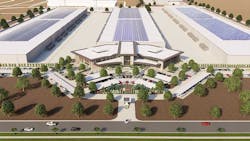Novva Launches to Build Hyperscale Data Center Campus in Salt Lake City
Wes Swenson knows the Salt Lake City data center market as well as anyone. He built C7 Data Centers into Utah’s leading colocation player before selling the company to DataBank in 2017.
Swenson believes the next phase of the region’s growth story will be hyperscale. That’s why he is launching Novva Data Centers, a new data center development company building a 1.5 million square foot campus in West Jordan, the site of a growing cloud cluster.
Novva makes its public debut today as the latest new entrant in the fast-growing digital infrastructure arena, pairing experienced executive leadership with a well-funded capital partner. Swenson is the founder and CEO, and Novva is backed by CIM Group, a Los Angeles real estate investment firm with a growing presence in the data center industry.
Swenson believes Salt Lake City is making the transition from a local colocation market to an attractive site for large-scale campuses for the leading players in the Internet economy. He says new tax incentives from the Utah legislature have created attractive economics to accompany the region’s strong fiber routes, favorable climate and affordable power.
‘This Is A Long Time Coming’
Novva expects invest $1 billion in its campus, starting with a 300,000 square foot data center that will be the first of four buildings on its 100-acre campus. Construction has been underway for four months, and Novva expects to bring its first customers online in early 2021, with an innovative cooling system and pre-leases from several tenants in place.
“This is a huge campus for Utah, and it’s a long time coming,” said Swenson. “What Utah has lacked is a really large-scale, purpose-built campus. With this type of campus, we can be competitive.
“This was a speculative data center when I started,” said Swenson. “But now we’re getting clients by word of mouth.”
The Salt Lake City region has several major data center campuses, including single-tenant sites for eBay and the National Security Agency, as well as a multi-tenant campus operated by Aligned. Facebook is building a major campus in Eagle Mountain, to the south of the city.
The region sits on long-haul fiber routes, with power available at 5.8 cents per kilowatt hour and a climate that supports using fresh air for cooling for about 75 to 80 percent of the year, which reduces cooling costs. Salt Lake City’s cost profile has been boosted by economic incentives passed this year that opened sales tax abatements on data center equipment to tenants of colocation space.
“That puts us pretty much on par with Arizona, Oregon, and even Nevada,” said Swenson, who expects to compete with those markets for tenants moving capacity out of California, which has been a beneficial trend for other Western markets.
“The issue in Utah for many years was that C7 was the largest provider, but we weren’t big enough for the ‘wholo’ market were wholesale meets colocation,” said Swenson. “We were starting to get into 2 or 3-megawatt deals, but didn’t really have the acreage to do those deals and provide room to grow. At Novva we are built for scale.”
A New Approach to Cooling
Novva intends to target customers seeking between 250 kW and 30 megawatts (MW) of capacity, and is offering both retail colocation and wholesale data center space. About 100,000 SF of the new facility will be configured for multi-tenant colocation (cabinets and cages), with the balance consisting of data suites for wholesale customers.
The carrier-neutral data center is designed to operate without water year-round (a major issue in Utah), and can use solar energy and be cooled with ambient air, keeping
sustainability at the forefront.
The most distinctive element of the Novva approach is a new cooling design, which employs a hot aisle containment system in which warm exhaust air moves beneath a 5-foot raised floor. In many newer data center designs, server exhaust is evacuated to an overhead plenum to be returned to the cooling equipment. Swenson likes the use of downward airflow, and worked with BASX Solutions to incorporate it into the Novva project.
“There’s quite a bit of science on the pressure,” said Swenson. “It’s a more efficient way to do it, but it’s very different. It’s taken us about three years to develop this system.”
The system uses filtered ambient air, which is moved into the data hall and through the server equipment, and into the contained hot-aisle. The combination of air pressure and a fan system below the 5-foot raised floor helps move the air back outside the data hall. At times when fresh air is too warm, Novva can use a glycol-based chiller for “trim” cooling.
CIM Builds its Data Center Presence
Novva is backed by the CIM Group, which has previously worked with 1547 Realty to build a data center portfolio with facilities in in Chicago, Toronto, Cheyenne, and Orangeburg, N.Y., as well as a new data center build at 400 Paul Avenue in San Francisco.
Swenson is an equity participant, and said the company has no debt and owns its 100-acre property, where Novva intends to build a total of four data centers, with subsequent buildings sized at about 400,000 square feet.
CIM “has really deep pockets and are invested in this sector,” said Swenson. “We expect to build out this campus over eight or nine years. I have a good idea of what product works here.
I’m building my vision, and I think Utah will rise.”
About the Author



